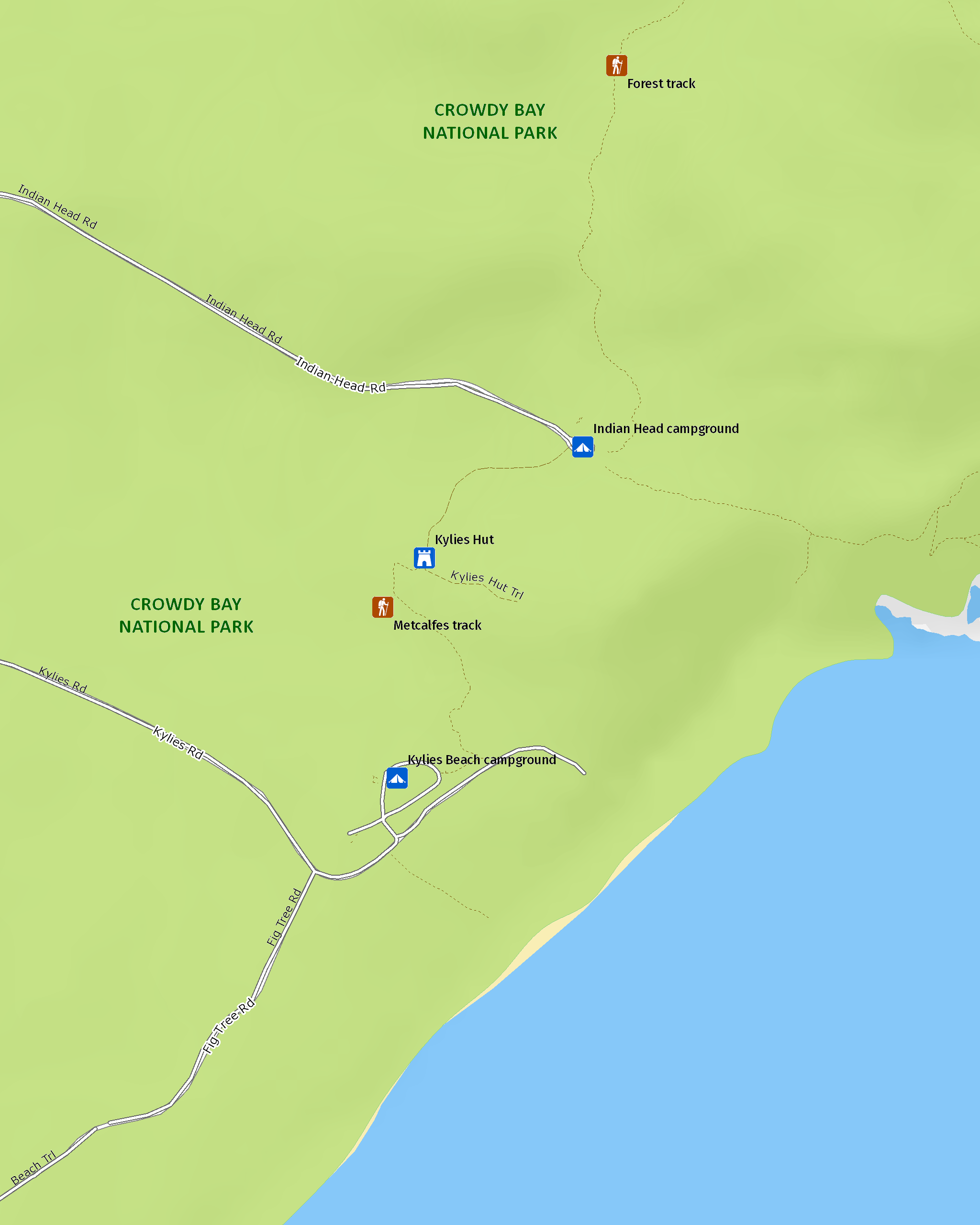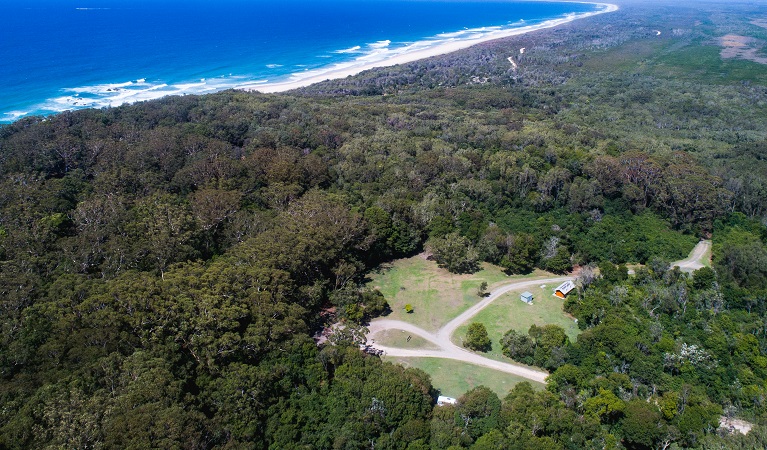Indian Head campground
Crowdy Bay National Park
Overview
Indian Head campground near Port Macquarie is great place to set up your campsite. There are plenty of walking opportunities, resident kangaroos and the beach is nearby.
| Camping type | Tent, Camper trailer site, Caravan site, Camping beside my vehicle |
|---|---|
| Facilities | Carpark, showers, toilets |
| What to bring | Drinking water, cooking water |
| Entry fees |
Park entry fees apply and can be purchased at time of booking. |
| Group bookings | Book up to 20 people or 5 sites online. For larger groups, make a group booking enquiry. |
| Please note |
|
Set on the western side of Diamond Head, Indian Head campground is a relaxed place to pitch a tent before your explorations of Crowdy Bay National Park begin. When your base camp’s established, it’s time to decide on your first adventure. A couple of the park’s walking tracks leave from the campground, including the scenic Forest walk and the longer Diamond Head Loop walk.
The beach is not far from the campground and is a great place for a spot of beach cricket or football. You might even see some of the park’s birdlife, like jabirus and pied oystercatchers. Of an evening, you can hear the crash of the ocean and if you are lucky, you might see some of the park’s kangaroos at dusk.
Take a virtual tour of Indian Head campground captured with Google Street View Trekker.
Map

Map legend

Local alerts
For the latest updates on fires, closures and other alerts in this area, see https://www.nationalparks.nsw.gov.au/camping-and-accommodation/campgrounds/indian-head-campground/local-alerts
Bookings
- National Parks Contact Centre
- 7am to 7pm daily
- 1300 072 757 (13000 PARKS) for the cost of a local call within Australia excluding mobiles
- parks.info@environment.nsw.gov.au
Operated by
- Port Macquarie office
- Monday to Friday, 9am to 4.30pm.
- 02 6588 5555 for general enquiries only, no bookings.
- npws.hastingsmacleay@environment.nsw.gov.au
- 22 Blackbutt Road, Port Macquarie NSW 2444
Park info
- in Crowdy Bay National Park in the North Coast region
Crowdy Bay National Park is always open but may have to close at times due to poor weather or fire danger.
-
Park entry fees:
$8 per vehicle per day.
Buy annual pass.
Visitor info
All the practical information you need to know about Indian Head campground.
Maps and downloads
Learn more
Indian Head campground is in Crowdy Bay National Park. Here are just some of the reasons why this park is special:
Gifts of nature

The views may grab the headlines, but within the park are more secretive delights that change with the seasons. These include rolling dunes that spring to life with wildflowers and migratory birds that populate the lagoons. There are lots of great lookouts to spot whales from as they migrate along the coast in winter or watch ospreys and falcons circle in the skies. Not to mention, kangaroos, koalas and cockatoos galore. Christmas visitors will receive an extra gift, Crowdy Bay's famous festive season blooms of Christmas bells.
- Mermaid lookout track Mermaid lookout track takes you on a tour of Crowdy Bay National Park's secret surprises. Secluded coves, sweeping beaches and mountain views await you on this short hike.
- Metcalfes walking track Get up close with nature on Metcalfes walking track, which links Indian Head and Kylies Beach in Crowdy Bay National Park. It's a family friendly hike and the kids might even spot a koala.
Past present

The Birpai People have climbed the headlands, swum in the rivers, crossed the sand dunes and walked the beaches of Crowdy Bay National Park for thousands of years. The sea and forest areas were a rich food source for the Birpai People, providing fish, shellfish, wallabies and berries. The park protects a number of Aboriginal sites, like shell middens and campsites, the oldest of which are about 6,000 years old. The park continues to be an important place for local Aboriginal people today.
Postcard perfect

This spectacular environment is truly something to write home about. If you can't find the words, try these - panoramic, breathtaking, even gobsmacking. Then again, you'll probably be too busy exploring the tracks, gazing agape at the huge rock arches, communing with wildlife or throwing a line to write lines on a postcard.
- Crowdy Gap walking track The short and sweet Crowdy Gap walking track in Crowdy Bay National Park, near Taree, offers a stroll through rainforest with scenic views and the chance to see koalas.
- Diamond Head Loop walk Diamond Head loop walk offers scenic coastal views across Crowdy Bay National Park. Expect beaches, lookouts, and glinting rock faces, giving Diamond Head its name.
Writers' retreat

During World War II, the Australian author Kylie Tennant moved to Laurieton where she met the reclusive Ernie Metcalfe, a farmer who grazed cattle on Diamond Head. Ernie built Kylie a timber slab hut to use as a writer's retreat. In return, Kylie portrayed Metcalfe and Crowdy Bay in the book The Man on the Headland. Kylie Tennant donated the hut and the surrounding land to Crowdy Bay National Park in 1976. If you're walking along Metcalfe walking track, stop to have a look inside Kylie's hut.
- Kylies Hut Visit Kylies Hut along Metcalfes walking track in Crowdy Bay National Park, near Port Macquarie. The historic hut was used as a writer’s retreat by award-winning Australian novelist Kylie Tennant.
Plants and animals protected in this park
Animals
-

White-bellied sea eagle (Haliaeetus leucogaster)
White-bellied sea eagles can be easily identified by their white tail and dark grey wings. These raptors are often spotted cruising the coastal breezes throughout Australia, and make for some scenic bird watching. Powerful Australian birds of prey, they are known to mate for life, and return each year to the same nest to breed.
-

Brown-striped frog (Lymnastes peronii)
One of the most common frogs found in Australia, the ground-dwelling brown-striped frog lives in ponds, dams and swamps along the east coast. Also known as the striped marsh frog, this amphibian grows to 6.5cm across and has a distinctive ‘tok’ call that can be heard all year round.
-

Lace monitor (Varanus varius)
One of Australia’s largest lizards, the carnivorous tree-dwelling lace monitor, or tree goanna, can grow to 2m in length and is found in forests and coastal tablelands across eastern Australia. These Australian animals are typically dark blue in colour with whitish spots or blotches.
Plants
-

Black sheoak (Allocasuarina littoralis)
The black sheoak is one of a number of casuarina species found across the east coast of Australia and nearby tablelands. Growing to a height of 5-15m, these hardy Australian native plants can survive in poor or sandy soils. The barrel-shaped cone of the black sheoak grows to 10-30mm long.
-

Grass tree (Xanthorrea spp.)
An iconic part of the Australian landscape, the grass tree is widespread across eastern NSW. These Australian native plants have a thick fire-blackened trunk and long spiked leaves. They are found in heath and open forests across eastern NSW. The grass tree grows 1-5m in height and produces striking white-flowered spikes which grow up to 1m long.
Environments in this park
Education resources (1)
Bookings
- National Parks Contact Centre
- 7am to 7pm daily
- 1300 072 757 (13000 PARKS) for the cost of a local call within Australia excluding mobiles
- parks.info@environment.nsw.gov.au
Operated by
- Port Macquarie office
- Monday to Friday, 9am to 4.30pm.
- 02 6588 5555 for general enquiries only, no bookings.
- npws.hastingsmacleay@environment.nsw.gov.au
- 22 Blackbutt Road, Port Macquarie NSW 2444
Park info
- in Crowdy Bay National Park in the North Coast region
Crowdy Bay National Park is always open but may have to close at times due to poor weather or fire danger.
-
Park entry fees:
$8 per vehicle per day.
Buy annual pass
What's nearby:
Things to do (21)
- Birdwatching and wildlife encounters (11)
- Canoeing/paddling (2)
- Fishing (4)
- Historic heritage (1)
- Photography (1)
- Picnics and barbecues (10)
- Sailing, boating and cruises (1)
- Sightseeing (10)
- Surfing (4)
- Swimming (3)
- Walking (10)
- Wildflowers (seasonal) (2)

